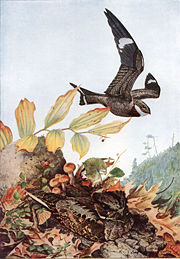Nightjar
- This article is about the bird. For the aircraft, see Gloster Nightjar.
| Nightjars | ||||||||||
|---|---|---|---|---|---|---|---|---|---|---|
 Common Nighthawk, Chordeiles minor, and Whip-poor-will, Caprimulgus vociferus
|
||||||||||
| Scientific classification | ||||||||||
|
||||||||||
| Genera | ||||||||||
|
14, see text. |
Nightjars are medium-sized nocturnal or crepuscular birds with long wings, short legs and very short bills. They are sometimes referred to as goatsuckers from the mistaken belief that they suck milk from goats (the Latin for goatsucker is Caprimulgus). Some North American species are named as nighthawks. Nightjars usually nest on the ground.
Nightjars are found around the world. They are mostly active in the late evening and early morning or at night, and feed predominantly on moths and other large flying insects.
Most have small feet, of little use for walking, and long pointed wings. Their soft plumage is cryptically coloured to resemble bark or leaves. Some species, unusual for birds, perch along a branch, rather than across it. This helps to conceal them during the day. Bracken is their preferred habitat.
The Common Poorwill, Phalaenoptilus nuttallii is unique as a bird that undergoes a form of hibernation, becoming torpid and with a much reduced body temperature for weeks or months, although other nightjars can enter a state of torpor for shorter periods.[1]
Nightjars lay one or two patterned eggs directly onto bare ground. It has been suggested that nightjars will move their eggs and chicks from the nesting site in the event of danger by carrying them in their mouths. This suggestion has been repeated many times in ornithology books, but while this may accidentally happen, surveys of nightjar research have found very little evidence to support this idea.[2][3]
Contents |
Systematics
Traditionally, nightjars have been divided into two subfamilies: the Caprimulginae, or typical nightjars with about 70 species, and the Chordeilinae, or nighthawks of the New World with about 9 species. The two groups are similar in most respects, but the typical nightjars have rictal bristles, longer bills, and softer plumage. In their pioneering DNA-DNA hybridisation work, Sibley and Ahlquist found that the genetic difference between the eared-nightjars and the typical nightjars was, in fact, greater than that between the typical nightjars and the nighthawks of the New World. Accordingly, they placed the eared-nightjars in a separate family: Eurostopodidae.
Subsequent work, both morphological and genetic, has provided support for the separation of the typical and the eared-nightjars, and some authorities have adopted this Sibley-Ahlquist recommendation, and also the more far-reaching one to group all the owls (traditionally Strigiformes) together in the Caprimulgiformes. The listing below retains a more orthodox arrangement, but recognises the eared-nightjars as a separate group. For more detail and an alternative classification scheme, see Caprimulgiformes and Sibley-Ahlquist taxonomy.
- Subfamily Chordeilinae (nighthawks)
- Genus Nyctiprogne (2 species)
- Genus Podager - Nacunda Nighthawk
- Genus Lurocalis (2 species)
- Genus Chordeiles (5 species)
- Subfamily Caprimulginae (typical nightjars)
- Genus Nyctidromus - Pauraque
- Genus Phalaenoptilus - Common Poorwill
- Genus Siphonorhis (2 living species)
- Genus Nyctiphrynus (4 species)
- Genus Caprimulgus (some 50-60 species)
- Genus Macrodipteryx - Long-primaried nightjars (2 species)
- Genus Hydropsalis (2 species)
- Genus Uropsalis (2 species)
- Genus Macropsalis - Long-trained Nightjar
- Genus Eleothreptus - Sickle-winged Nightjar
Also see a list of nightjars, sortable by common and binomial names.
Gallery
References
- ↑ Lane JE, Brigham RM, Swanson DL. (2004) "Daily torpor in free-ranging whip-poor-wills (Caprimulgus vociferus)." Physiological and Biochemical Zoology 77 (2):297-304
- ↑ Jackson, H.D. (2007) " A review of the evidence for the translocation of eggs and young by nightjars (Caprimulgidae)" Ostrich - Journal of African Ornithology, 78 (3) 561-572
- ↑ Jackson, H.D. (1985) "Commentary and Observations on the Alleged Transportation of Eggs and Young by Caprimulgids". Wilson Bulletin 97 (3) 381-385 [1]
External links
- Internet Bird Collection: Nightjar videos. Retrieved 2006-DEC-02.
- Nightjar sounds on xeno-canto.org